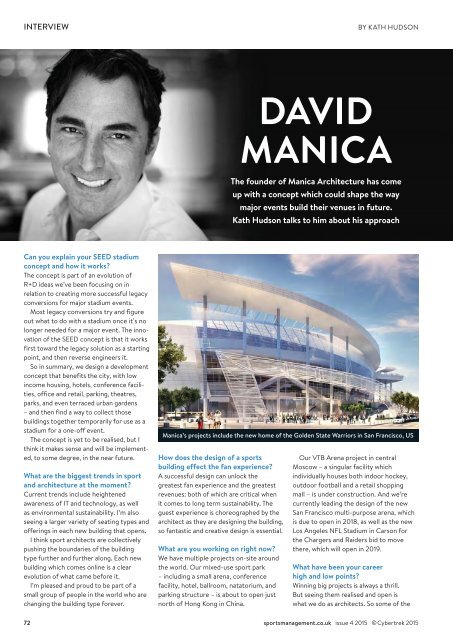EDDIE IZZARD
SM_issue4_2015
SM_issue4_2015
You also want an ePaper? Increase the reach of your titles
YUMPU automatically turns print PDFs into web optimized ePapers that Google loves.
INTERVIEW<br />
BY KATH HUDSON<br />
DAVID<br />
MANICA<br />
The founder of Manica Architecture has come<br />
up with a concept which could shape the way<br />
major events build their venues in future.<br />
Kath Hudson talks to him about his approach<br />
Can you explain your SEED stadium<br />
concept and how it works?<br />
The concept is part of an evolution of<br />
R+D ideas we’ve been focusing on in<br />
relation to creating more successful legacy<br />
conversions for major stadium events.<br />
Most legacy conversions try and figure<br />
out what to do with a stadium once it’s no<br />
longer needed for a major event. The innovation<br />
of the SEED concept is that it works<br />
first toward the legacy solution as a starting<br />
point, and then reverse engineers it.<br />
So in summary, we design a development<br />
concept that benefits the city, with low<br />
income housing, hotels, conference facilities,<br />
office and retail, parking, theatres,<br />
parks, and even terraced urban gardens<br />
– and then find a way to collect those<br />
buildings together temporarily for use as a<br />
stadium for a one-off event.<br />
The concept is yet to be realised, but I<br />
think it makes sense and will be implemented,<br />
to some degree, in the near future.<br />
What are the biggest trends in sport<br />
and architecture at the moment?<br />
Current trends include heightened<br />
awareness of IT and technology, as well<br />
as environmental sustainability. I’m also<br />
seeing a larger variety of seating types and<br />
offerings in each new building that opens.<br />
I think sport architects are collectively<br />
pushing the boundaries of the building<br />
type further and further along. Each new<br />
building which comes online is a clear<br />
evolution of what came before it.<br />
I’m pleased and proud to be part of a<br />
small group of people in the world who are<br />
changing the building type forever.<br />
Manica’s projects include the new home of the Golden State Warriors in San Francisco, US<br />
How does the design of a sports<br />
building effect the fan experience?<br />
A successful design can unlock the<br />
greatest fan experience and the greatest<br />
revenues: both of which are critical when<br />
it comes to long term sustainability. The<br />
guest experience is choreographed by the<br />
architect as they are designing the building,<br />
so fantastic and creative design is essential.<br />
What are you working on right now?<br />
We have multiple projects on-site around<br />
the world. Our mixed-use sport park<br />
– including a small arena, conference<br />
facility, hotel, ballroom, natatorium, and<br />
parking structure – is about to open just<br />
north of Hong Kong in China.<br />
Our VTB Arena project in central<br />
Moscow – a singular facility which<br />
individually houses both indoor hockey,<br />
outdoor football and a retail shopping<br />
mall – is under construction. And we’re<br />
currently leading the design of the new<br />
San Francisco multi-purpose arena, which<br />
is due to open in 2018, as well as the new<br />
Los Angeles NFL Stadium in Carson for<br />
the Chargers and Raiders bid to move<br />
there, which will open in 2019.<br />
What have been your career<br />
high and low points?<br />
Winning big projects is always a thrill.<br />
But seeing them realised and open is<br />
what we do as architects. So some of the<br />
72<br />
sportsmanagement.co.uk issue 4 2015 © Cybertrek 2015


